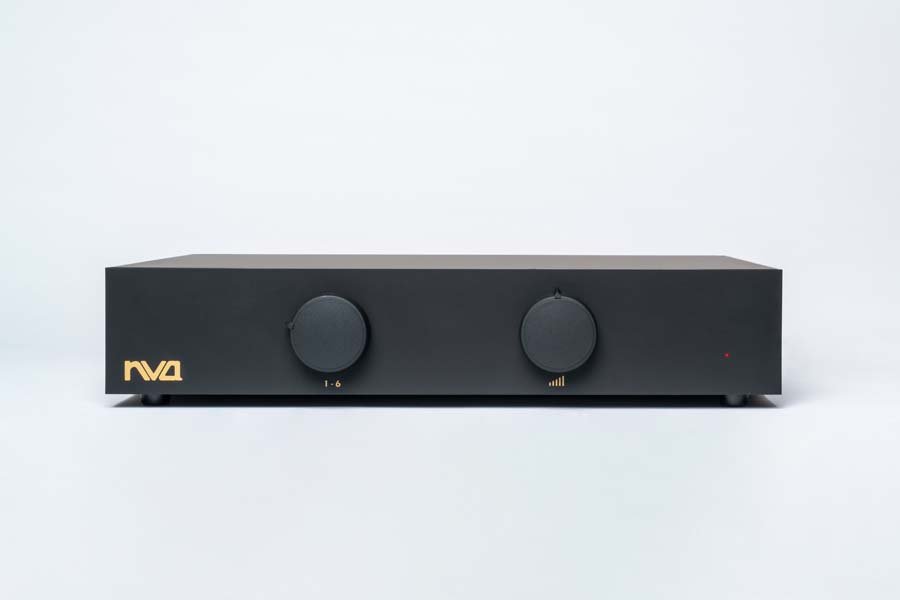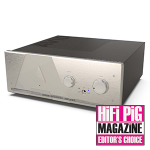NVA INT400 INTEGRATED AMPLIFIER REVIEW
Richard Dunn passed away in 2019 but his legacy and products live on with new owners who are keen to maintain many of his core values with regard to amplifier design. Janine Elliot takes a listen to the UK-based company’s INT400 integrated amplifier costing £3500 and coming with its own loudspeaker cables.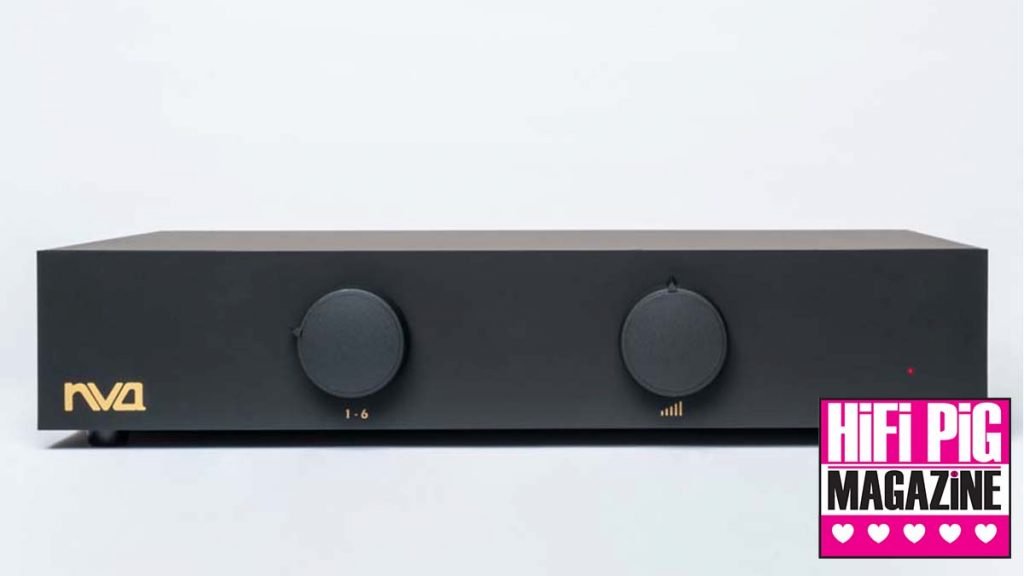
I was sent a large but thin box containing an amplifier from a company that I initially thought I had no previous knowledge of. NVA produce solid-state amplifiers and their history goes back to a certain Richard Dunn and a professional amplifier company I actually do remember from my long distant youth called Thresham Audio from the 70’s.
NVA or Nene Valley Audio, to give it its full name, has its roots in Peterborough, where the Nene Valley and the historical Nene Valley Railway run through. The late Richard Dunn was quite a character, fixed in his own radical ideas, and these ideas have continued from Thresham Audio into the company that exists today. Like many, Richard had worked in amplification on an amateur basis for many years before Thresham Audio had its roots, building amplifiers as a hobby in the 1960’s. Thresham Audio was sold to Tannoy in 1982, after rising to fame for producing the first non-application-note FET amplifier, the SR402, a professional studio amp of 200W into 8 ohms or 1000W 4 ohms when bridged. Quite some beast. Richard Dunn founded NVA in 1982, though it is now owned by others, and it now has three amplifiers in the “INT” (Integrated) range; the INT250 has a single 250VA power supply and entry-level potentiometer, the INT400 has twin power supply totaling 400VA with a premium pot, and the top model INT400SA has twin power supply with 34-step attenuator. The twin power supplies are made up of 150VA and 250VA in the first and output stages respectively. The model for review here is the second model in the series coming in at £3500 (the others are £2500 and £4500). You can upgrade your amplifier if you ever need to by sending the machine back to NVA and having it retrofitted. Today all NVA amplifiers are built by hand in the UK at their workshop further north just outside Durham City. They also make passive preamps, power amps, phono-stages, and a headphone amplifier, and are developing a unique loudspeaker design as I write. In addition, they produce cables, and the INT400 comes complete with their own low capacitance LS Series cable, gratis, as they don’t recommend using any other (and whatever length you need), as the circuitry works best with low capacitance cables. Indeed, it does state in the instruction booklet that “Use of non-NVA speaker cables will invalidate the NVA warranty”. The positive and negative wires are not intertwined; capacitance increases the closer the cables are to each other, so by keeping them at a distance solves part of this issue. So don’t wrap the cables together even if you think that looks best!
THE BOX
When I opened the carton, I was introduced to a pair of white gloves to remove the unit. Quite apt; the model is encased in beautiful satin-matt acrylic rather than the usual aluminium case. This was something that Richard Dunn stipulated; he noticed that after building amps on the work-bench they sounded different as soon as you encased them in metal. Believing that the metal affects the components he made sure his products would only have a plastic case. This also means that the amplifier is class II and therefore has a captive mains cable. There isn’t any circuit protection inside and certainly no internal fuse. Richard Dunn didn’t like such things as he found they affected the sound quality and “killed the music”. Also, as Richard wanted to produce amps with a clean sound and wide bandwidth he took out every unnecessary capacitor and filtering circuitry.
After admiring the case and switching it on, you’re ready to listen to your music, though I did feel it needed to be switched on for half an hour to get the best sound. I love the case! Coming in a dust free in its matt state I did wonder if the Class AB amplifier might get too hot inside as there are no vents or visible fins. I worried for no reason as the amp gets barely warm and is actually designed to be left switched on permanently for best results (the on-off switch is at the back should you ever need it). The literature does however suggest the occasional checking on temperature if you do leave the amplifier on all the time, as there is no thermal cut-off circuitry. You certainly need to keep it switched on for the first 72 hours to get the capacitors fully formed. The heatsink is inside at the base of the unit. There are no screws to fix the box together. It is glued, so if you do need to change a capacitor you’ll need to wrench it apart – and so a job best left to NVA themselves. Its minimalistic looks mean that as well as a red LED there are just two large knobs; the left to select the six RCA line-level inputs and the right one to change the volume of this 70Watt amplifier. There is also a record output should you still have a cassette recorder lying about the house. Speaker sockets are only bananas, but since the supplied cables are bananas that doesn’t matter. The amp comes with a five-year first-user guarantee.
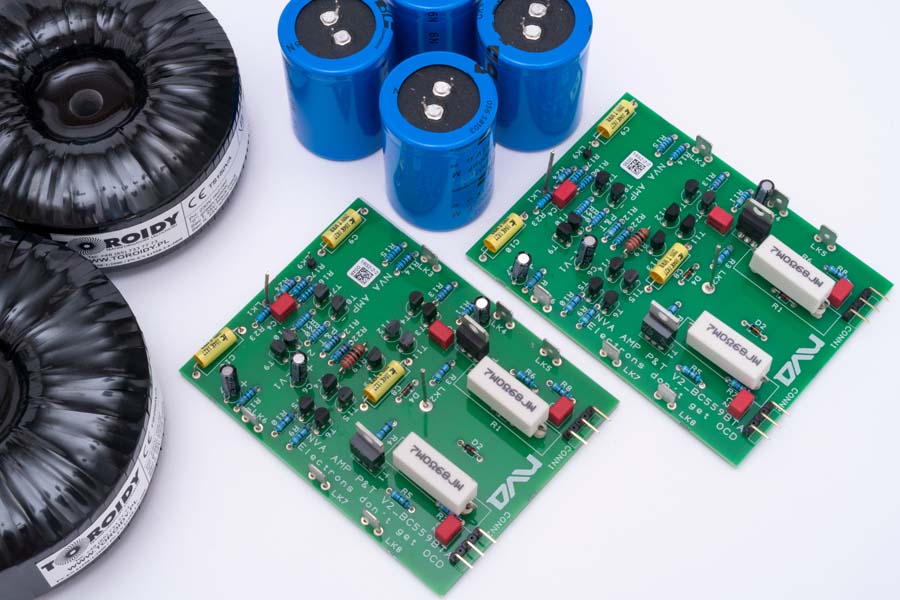
Some of the guts of the NVA INT400
MATING THE NVA INTEGRATED WITH LOUDSPEAKERS
After putting away your prized speaker cables and connecting up the NVA they advise not to use loudspeakers with high-frequency notch filters or complicated crossovers, such as BBC LS3/5a’s and my LS5/9s. They recommend simple first-order crossovers, or preferably none at all. I decided to use my Wilson Benesch Arcs, though I did try the LS5/9s to see how it sounded at one point! I did find the amplifier worked well with whatever I connected it to, and despite the uniqueness of this product felt it was extremely musical and detailed.
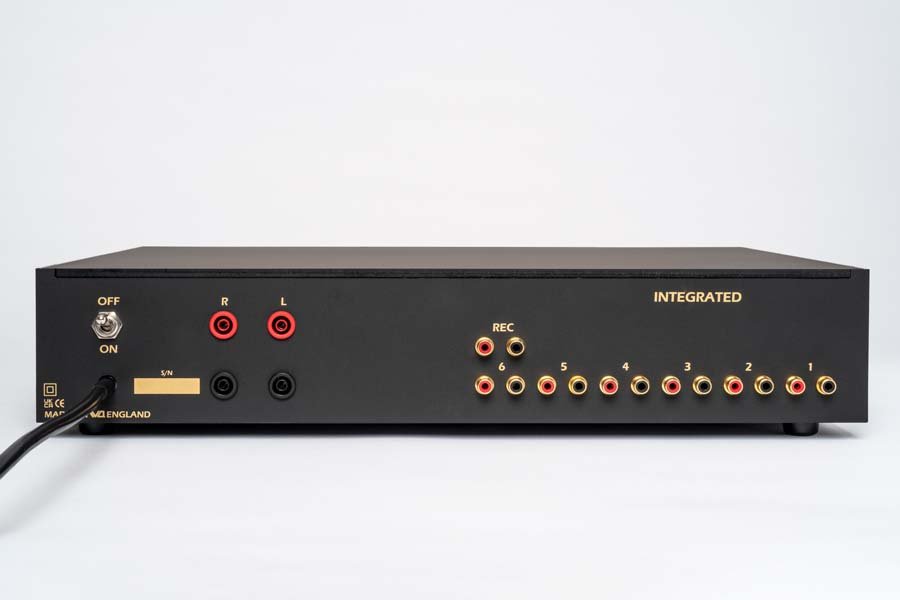
The NVA INT400 is a Class 2 product and as such has its own power cable. The amp also comes with its own very specific speaker cables – the use of other speaker cables voids the warranty.
SOUND OF THE INT400 AMPLIFIER
This might be quite an unusual player in terms of its design, but that didn’t take anything away from its sound. This was an excellent player; a cross between valve and solid state; detailed but not so much as to take anything away from the music. Indeed, I could listen to it for ages, but it wasn’t a pipe and slippers sound; it kept you interested in the music you were playing and at times showed me characteristics of the music I hadn’t heard before.
There was excellent clarity and an openness to the sound, though adding a bit of that valve musicality encouraged me to keep on listening. The loudspeaker cable was very good, especially for something that is included in the price; copper in Teflon dielectric with 14 individual isolated cores. The wiring inside the amp is silver plated, connecting the passive preamplifier to the volume control and power amp.
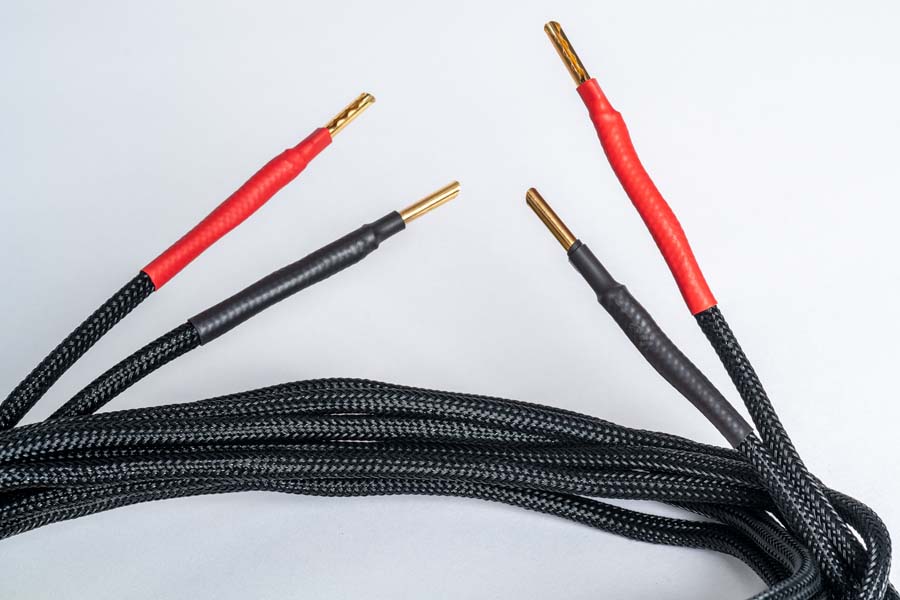
The INT400 from NVA comes with its own speaker cables.
This amplifier is exceptionally quiet. I could listen intently to the music and the only hiss was coming from the recording itself, or in the case of Patricia Barber’s ‘Live in Paris’ the audience noise. Here the music was clear and accurate. The bass was exceptionally fast as was the top percussion. I could dig deep into the detail without spoiling the music. This speed of retrieval of the music was something I found also excellent in Pat Matheny’s ‘The Way Up’. Here fast transients and extremely good positioning of instruments make the INT 400 an amplifier that would satisfy the most discerning audiophile or professional. Lower bass was good, something the WB Arc’s generally lack, and Patricia Barber’s “Laura” is a track that has tons of bass that illustrates just how good it could be. Additionally, there was still a smoothness in the music to rival valve beauties.
Turning to classics I found the amp was indeed smooth and rich with lots of detail, especially in the depth of the soundstage, and full of fast transients. Tchaikovsky’s “Prelude and Dance of the Swans” was rich in harmony and meter, and Prokofiev’s Piano Concerto No3, also on the LP (Kirill Kondrashin, Moscow Philharmonic), was persuasive enough to get even the classic diehard to sit up to attention. This LP was presented carefully with clear percussion and piano.
Tomita’s ‘Live at Linz’ is an amazing album, mixing classical instruments with electronica that has made him so famous. His Vaughan Williams “The Lark Ascending” recorded live in Austria in 1984 was musical and silky smooth and controlled, despite the synthesizers playing alongside the violin solo from Mariko Senja. Even the noise of the helicopter flying overhead from left to right worked well in this recording. The concert was staged on the shore of the Danube, a 13-channel multi-speaker event with one speaker in the helicopter flying 1500 feet above, another speaker on the other side of the river, and a further speaker on a ship, where the violinist played!
The amplifier worked well with all instruments and music types, just slightly lacking on the excitement front at times. For accuracy and quietness in operation, though, this was an excellent amp at the price. Tony Bank’s ‘A Curious Feeling’ begins with a forceful pianoforte introduction. The drums, synth, and vocals were all correct and the amp was again quick and accurate. It didn’t add anything nor take anything away from the music but was just a little less commanding than I would perhaps like. It was accurate, though, and after all, that is what a good amp should be, whether for home or studio. Going back to the professional roots of Thresham Audio, things hadn’t changed a lot, then. This could easily be recommended for the small studio as well as the living room.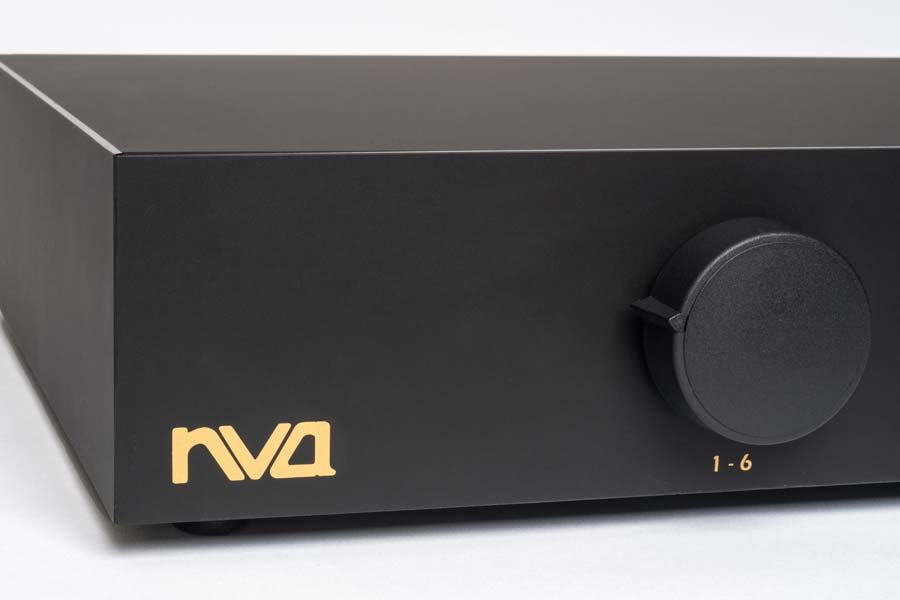
CONCLUSION
The NVA amplifier might be interesting in terms of its quirks; glued acrylic box, no protection circuitry, and use of its own cable, but once you get to understand why these features are needed then you begin to see and hear that this is indeed a quite serious piece of kit. Richard Dunn might have died in 2019 but his legacy continues in NVA to this day. Coming somewhere between valve and solid state in sound, this is a detailed amplifier with a great bass and midrange an accurate top end, and with an excellent low noise floor. This amp is well worth listening to if you don’t mind ditching your expensive speaker cables.
AT A GLANCE
Build Quality:
Well-made acrylic construction that would look lovely in your living room, one that is far easier to dust than most!
Sound Quality:
A well-balanced sound across all frequencies makes it suitable for all types of music
Value For Money:
£3500 is good value for amount of enjoyment it gave me
We Loved:
Bass extension
Excellent noise floor
Revealing and concise performance
SS detail and valve warmth
We Didn’t Love So Much:
The acrylic finish is glued together
Price: £3500
Elevator Pitch Review: An amp that comes with its own cabling might put off some people, but once I got to grips with understanding the design and then listening to the NVA Int400 it all made sense. This might be a bit marmite, but I love marmite and found the warmth and detail of this amplifier well worth listening to.

Janine Elliot
Review Equipment: Pre-Audio GL-1102N/AT33sa (turntable/cartridge); Manley Steelhead (phono stage); Krell KPS20i (CD); Ferrograph Logic7 (reel to reel); Astell and Kern SE180/iFi xDSD (DAP/streamer); NVA, Esprit and Townshend cables; Coppice Audio and Townshend rack.
Specification
- Includes NVA LS3 speaker cables to your required lengths
- New satin-matt finish hides dust and fingerprints
- Audio-grade Toroidy transformers
- High quality Vishay capacitors
- Inputs – 6 line level
- Output – Tape-Out or Pre-Out (state preference when ordering)
- Power Output – 70w
- 2 power supply options; single 250va power supply or 400va twin supply (150va on input, 250va on output)
- Premium volume pots; TKD in INT400, or 34 step attenuator in INT400SA
- Upgrade to higher specification, at any time, by paying only the difference in price
- Dimensions – w240mm x h160mm x d240mm
- Made to order – (contact usfor estimated delivery date)
- 30 day home trial
- 5 year, first-user warranty
















































